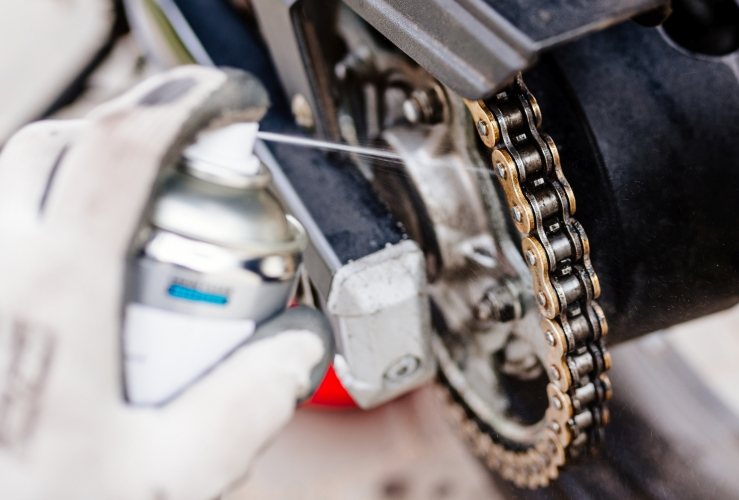The majority of motorcycle drive systems feature a pair of sprockets: one usually referred to as the front sprocket (or drive sprocket), the other as the rear sprocket (or driven sprocket).
The engine transmission shaft drives the front sprocket, which pulls the chain and turns the rear sprocket, moving the machine forward.
Each sprocket has teeth which precisely fit into the chain, distributing the force equally.
The vast majority of production motorcycle sprockets are made of steel. Aluminium sprockets are sometimes used in very high performance bikes, but these wear out faster.
The front sprocket is the smaller of the two, featuring 10-18 teeth, while the larger rear sprocket features 28-64 teeth. Very high performance bikes sometimes use a third sprocket to maintain tension.
A bike’s performance characteristics can be affected by the size ratio between the front and the rear sprockets.

The components of a regular chain link are: inner and outer plates; a pin; bushing; and a roller. O-rings or X-rings are sometimes used to seal these links. These are usually made of rubber and create a barrier between outer and inner plates. As well as helping to maintain lubrication, these rings help to keep the link clean. Chains that have not been sealed tend to be affected by low levels of friction, but do wear out more quickly than sealed chains.
When replacing your chain, it’s prudent to select a product of equal or greater strength; if you bought your bike with a sealed chain, you should replace it with a sealed chain.
You should lubricate your sealed chain once every 300 miles in order to prevent rust. Non-sealed chains should be lubricated once every 100 miles.
Through time, as the pin rotates inside the bushing, both components become worn – effectively making the chain longer and therefore looser.
To check if your chain is worn, pull on the rear sprocket while lifting the chain in the middle. If you are able to lift the chain by 1/4 inch or more, it has become worn and should be replaced as soon as possible.
Another way to check if your chain is worn is by taking it off and measuring it (not an easy task in itself): if it is 2.5% longer than when it was fitted, it has elongated too much and should be replaced.
Teeth can snap off if the chain is too loose, or if the links are too tight. This can cause the chain to snap – a very dangerous eventuality. It is important to examine your chain for wear on a regular basis.
Sprocket teeth become worn through constant interaction with the chain. When the teeth have become sharp (or 'hooked') rather than blunt, it is time to replace the sprocket.
You should change both your chain and your sprockets at the same time. New chains and sprockets are manufactured at exactly the same pitch, which means they wear out together at the same rate. A new chain on old sprockets could make for an incongruous match, reducing performance and accelerating the rate of wear.
Your chain and sprockets must be in exact alignment in order to prevent unnecessary wear and the possibility of a snapped chain. If the teeth of your sprockets are worn on one side but not the other, the chain is out of alignment. Special manufacturer marks on the swinging arm can be used to align the chain, but these are not considered precise enough. Laser alignment tools can help to determine if a chain is running straight.
- Make sure your motorbike has the right chain: fitting a chain for a 125cc scooter to a 1000cc superbike is sure to cause problems.
- Lubricate your chain regularly: once every 300 miles for a sealed chain; once every 100 miles for an unsealed chain.
- Ensure your chain is fitted with the correct tension. Chains that are fitted too tight can overheat and snap – an eventuality that is even more likely if the chain is not well lubricated.
- Ensure your chain is properly aligned.
- Ensuring your chain is not damaged by leaking battery acid or trapped debris.
If your chain has become worn or loose, change it as soon as possible – along with both sprockets.




